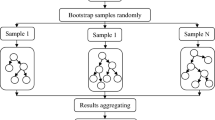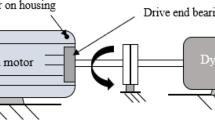Abstract
Background
Pelton wheel works on Newton's law which converts the kinetic energy of fluid into mechanical energy. Bearing, nozzle, servomotor and buckets are the main components of the Pelton wheel that are prone to defects. Corrosion by reactive materials, degradation by strong slurry particles, the involvement of some metallurgical defects, cavitation, and poor bearing lubrication are some of the causes which induce defects in the Pelton wheel. These failures result in significant turbine disruption, costly disassembly, and, in some cases, full Pelton wheel shutdown. Hence, it becomes a necessity to monitor the Pelton wheel through some suitable methods.
Purpose
A novel artificial intelligence-based method has been investigated to describe the health condition of a Pelton wheel. Traditionally, extracted features from stationary wavelet transform (SWT) decomposed signal to increase the complexity and affect the classification accuracy. This issue is resolved by developing a new fault diagnosis scheme using improved Shannon entropy based on expectation maximization principal component analysis (EM-PCA) and extreme learning machine (ELM).
Methods
In the proposed scheme, F-score is initially applied to select features and construct the feature matrix. At the same time, EM-PCA is used to reduce the dimension of the constructed feature matrix, which reduces the correlation between data and eliminate the redundancy to retain the essential features for the ELM classification model.
Conclusion
The effectiveness of the proposed scheme is compared with other reduction techniques used for the purpose. A comparison has also been made with other classification methods. The results show that EM-PCA with improved Shannon entropy can effectively eliminate correlation and redundancy of data. Further, the use of the ELM can take on better adaptability, faster computation speed and higher classification rate. The proposed method is fast as it takes 0.0020 s of computation time for both training and testing with 89.14% and 96.33% training and testing accuracies, respectively.









Similar content being viewed by others
References
Egusquiza M, Egusquiza E, Valentin D, Valero C, Presas A (2017) Failure investigation of a Pelton turbine runner. Eng Fail Anal 81:234–244
Egusquiza M et al (2018) Advanced condition monitoring of Pelton turbines. Measurement 119:46–55
Brekke H (2001) Design, erection and operation by Hermod Brekke. NTNU, Trondheim
Vashishtha G, Kumar R (2021) An effective health indicator for the Pelton wheel using a Levy flight mutated. Meas Sci Technol 32:094003
Carp-Ciocardia D-C, Safta C, Dragomirescu A, Magheti I, Schiaua M (2018) Experimental analysis of vibrations at a pelton turbine. Proc. Annu. Symp Inst Solid Mech Sess Comm Acoust 59:7–10
Chávez JC, Valencia JA, Jaramillo GA, Coronado JJ, Rodríguez SA (2015) Failure analysis of a Pelton impeller. Eng Fail Anal 48:297–307
Kumar A, Kumar R (2017) Time-frequency analysis and support vector machine in automatic detection of defect from vibration signal of centrifugal pump. Measurement 108:119–133
Wang D, Miao Q, Fan X, Huang H (2009) Rolling element bearing fault detection using an improved combination of Hilbert and Wavelet transforms. J Mech Sci Technol 23:3292–3301
Li Z, Feng Z, Chu F (2014) A load identification method based on wavelet multi-resolution analysis. J Sound Vib 333:381–391
Li Y, Xu M, Haiyang Z, Wei Y, Huang W (2015) A new rotating machinery fault diagnosis method based on improved local mean decomposition. Digit Signal Process A Rev J 46:201–214
Han D, Zhao N, Shi P (2019) Gear fault feature extraction and diagnosis method under different load excitation based on EMD, PSO-SVM and fractal box dimension. J Mech Sci Technol 33:487–494
Kumar A, Kumar R (2019) Role of signal processing, modeling and decision making in the diagnosis of rolling element bearing defect: a review. J Nondestruct Eval 38:1–29
Vashishtha G, Chauhan S, Singh M, Kumar R (2021) Bearing defect identification by swarm decomposition considering permutation entropy measure and opposition-based slime mould algorithm. Measurement 178:109389
Wang L, Shao Y (2020) Fault feature extraction of rotating machinery using a reweighted complete ensemble empirical mode decomposition with adaptive noise and demodulation analysis. Mech Syst Signal Process 138:106545
Chauhan S, Singh M, Kumar Aggarwal A (2020) An effective health indicator for bearing using corrected conditional entropy through diversity-driven multi-parent evolutionary algorithm. Struct Health Monit. https://doi.org/10.1177/1475921720962419
Kumar A, Gandhi CP, Zhou Y, Vashishtha G, Kumar R (2020) Improved CNN for the diagnosis of engine defects of 2-wheeler vehicle using wavelet synchro-squeezed transform ( WSST ). Knowl-Based Syst 208:106453
Zhang X, Miao Q, Zhang H, Wang L (2018) A parameter-adaptive VMD method based on grasshopper optimization algorithm to analyze vibration signals from rotating machinery. Mech Syst Signal Process 108:58–72
Zhao Q, Han T, Jiang D, Yin K (2019) Application of variational mode decomposition to feature isolation and diagnosis in a wind turbine. J Vib Eng Technol 7:639–646
Lobato THG, da Silva RR, da Costa ES, Mesquita ALA (2020) An integrated approach to rotating machinery fault diagnosis using, EEMD, SVM, and augmented data. J Vib Eng Technol 8:403–408
Omoregbee HO, Heyns PS (2019) Fault classification of low-speed bearings based on support vector machine for regression and genetic algorithms using acoustic emission. J Vib Eng Technol 7:455–464
Wang J, Li S, Xin Y, An Z (2019) Gear fault intelligent diagnosis based on frequency-domain feature extraction. J Vib Eng Technol 7:159–166
Chen W, Yu M, Fang M (2021) Research on identification and localization of rotor stator rubbing faults based on AF-VMD-KNN. J Vib Eng Technol. https://doi.org/10.1007/s42417-021-00357-z
Cheng Y, Zou D (2019) Complementary ensemble local means decomposition method and its application to rolling element bearings fault diagnosis. Proc Inst Tech Eng Part O J Risk Reliab 233:868–880
Maosen C, Pizhong Q (2008) Integrated wavlet transform and its application to vibration mode shapes for the damage detection of beam type structure. Smart Mater Struct 17:1–17
Fan W, Xue H, Yi C, Xu Z (2020) TQWT-assisted statistical process control method for condition monitoring and fault diagnosis of bearings in high-speed rail. Proc Inst Mech Eng Part O J Risk Reliab. https://doi.org/10.1177/1748006X20958321
Al Tobi M, Bevan G, Wallace P, Harrison D, Okedu KE (2020) Faults diagnosis of a centrifugal pump using multilayer perceptron genetic algorithm back propagation and support vector machine with discrete wavelet transform-based feature extraction. Comput Intell. https://doi.org/10.1111/coin.12390
Sharma S, Tiwari SK, Singh S (2021) Integrated approach based on flexible analytical wavelet transform and permutation entropy for fault detection in rotary machines. Meas J Int Meas Conf 169:108389
Chen Z, Zi Y, Li P, Chen J, Xu K (2020) An energy time-convexity second-order synchrosqueezing transform and application in weak fault diagnosis of rolling bearings in aerospace engine. Meas Sci Technol 31:125105
Toma RN, Kim JM (2020) Article bearing fault classification of induction motors using discrete wavelet transform and ensemble machine learning algorithms. Appl Sci 10:5251
Wu JD, Hsu CC (2009) Fault gear identification using vibration signal with discrete wavelet transform technique and fuzzy-logic inference. Expert Syst Appl 36:3785–3794
Kumar A, Gandhi CP, Zhou Y, Kumar R, Xiang J (2020) Improved deep convolution neural network ( CNN ) for the identification of defects in the centrifugal pump using acoustic images. Appl Acoust 167:107399
Halligan GR, Jagannathan S (2011) PCA-based fault isolation and prognosis with application to pump. Int J Adv Manuf Technol 55:699–707
Kumar A et al (2020) A novel health indicator developed using filter-based feature selection algorithm for the identification of rotor defects. Proc Inst Mech Eng Part O J Risk Reliab. https://doi.org/10.1177/1748006X20916953
Sun W, Chen J, Li J (2007) Decision tree and PCA-based fault diagnosis of rotating machinery. Mech Syst Signal Process 21:1300–1317
Liang J, Zhang Y, Zhong JH, Yang H (2019) A novel multi-segment feature fusion based fault classification approach for rotating machinery. Mech Syst Signal Process 122:19–41
She D, Jia MG, PM (2020) Sparse auto-encoder with regularization method for health indicator construction and remaining useful life prediction of rolling bearing. Meas Sci Technol 31:105005
Du G, Xu Q, Yang Y (2020) Fault diagnosis of rotating machinery components using deep kernel extreme learning machine under different working conditions. Meas Sci Technol 31:115901
Noman K, He Q, Peng Z, Wang D (2020) A scale independent flexible bearing health monitoring index based on time frequency manifold energy & entropy. Meas Sci Technol 31:114003
Keskes H, Braham A, Lachiri Z (2013) Broken rotor bar diagnosis in induction machines through stationary wavelet packet transform and multiclass wavelet SVM. Electr Power Syst Res 97:151–157
Lala H, Karmakar S, Ganguly S (2018) Fault diagnosis in distribution power systems using stationary wavelet transform and artificial neural network. In: 2017 7th Int. Conf. Power Syst. ICPS 2017, pp 121–126. https://doi.org/10.1109/ICPES.2017.8387279
Kankar PK, Sharma SC, Harsha SP (2011) Rolling element bearing fault diagnosis using wavelet transform. Neurocomputing 74:1638–1645
Chen Z, Li Y, Liang H, Yu J (2019) Improved permutation entropy for measuring complexity of time series under noisy condition. Complexity
Polat K, Güneş S (2009) A new feature selection method on classification of medical datasets: Kernel F-score feature selection. Expert Syst Appl 36:10367–10373
Zhao L, Chai T, Cong Q (2006) Operating condition recognition of pre-denitrification bioprocess using robust EMPCA and FCM. Proc World Congr Intell Control Autom 2:9386–9390
Huang G-B, Zhu Q-Y, Siew C-K (2006) Extreme learning machine: theory and applications. Neurocomputing 70:489–501
Ding S, Zhao H, Zhang Y, Xu X, Nie R (2015) Extreme learning machine: algorithm, theory and applications. Artif Intell Rev 44:103–115
Acknowledgements
Authors are grateful to All India Council for Technical Education (AICTE), New Delhi, India, for financial support (Project No. 8-29/RIFD/RPS-NDF/Policy-1/2018-19) to carry out this research work.
Author information
Authors and Affiliations
Corresponding author
Ethics declarations
Conflict of Interest
Authors declare that they have no conflict of interest.
Additional information
Publisher's Note
Springer Nature remains neutral with regard to jurisdictional claims in published maps and institutional affiliations.
Rights and permissions
About this article
Cite this article
Vashishtha, G., Kumar, R. Pelton Wheel Bucket Fault Diagnosis Using Improved Shannon Entropy and Expectation Maximization Principal Component Analysis. J. Vib. Eng. Technol. 10, 335–349 (2022). https://doi.org/10.1007/s42417-021-00379-7
Received:
Revised:
Accepted:
Published:
Issue Date:
DOI: https://doi.org/10.1007/s42417-021-00379-7




